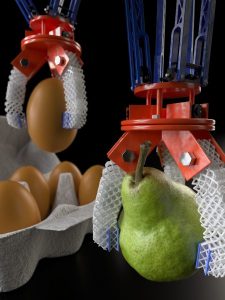Current commercial robots typically contain hard parts that pose a risk to the safety of their operators or limit their ease of use. In response to this, soft robots have recently attracted considerable attention, although their lack of structural rigidity heavily limits their use in many practical applications.
Over the last several years, researchers have sought to create robotic personal assistants and bionic limbs or prosthetics that combine the durability of common robots with the flexibility of soft robots. More recently, combinations of cellular structures have shown interesting progress toward the enhancement of non-trivial capabilities, such as grasping uniquely shaped objects. However, tuning the mechanical properties of the robotic body for custom applications is still very challenging.
 In their latest study published in Advanced Intelligent Systems, Woo Soo Kim and colleagues from the School of Mechatronic Systems Engineering, Simon Fraser University used 3D printing to fabricate an architectured robotic body with deformable lightweight cellular structures.
In their latest study published in Advanced Intelligent Systems, Woo Soo Kim and colleagues from the School of Mechatronic Systems Engineering, Simon Fraser University used 3D printing to fabricate an architectured robotic body with deformable lightweight cellular structures.
The team designed 3D-printed polymers structured with a unique truss design that can be “tuned” to different rigidities, from soft and rubbery to hard and metallic. By using 3D printing, the robot fingers could be efficiently manufactured, allowing the concurrent integration of an actuator, a pressure sensor, and the 3D cellular body. Owing to its properties, the flexible material provided the robot finger with human-like movement, but also with shock and vibration absorption properties, resulting in a superior protection of the internal electrical components.
By virtue of the architectured cellular technology, the robotic gripper was capable of handling soft objects such as bell peppers, tomatoes, and even eggs without breaking or damaging them, mimicking the strength and tenderness of a human hand.
“The results of this work demonstrate the potential of 3D-printed architectured robot bodies and anticipate the development of adaptable to custom-designed robot applications in the near future,” says Prof. Woo Soo Kim.
This technology could find application in prosthetic limbs and humanoid robots that are both durable enough for everyday use, but sufficiently soft to complete delicate tasks. In addition, robots equipped with flexible fingers could help improve the quality of life for people with mobility challenges or limb differences by acting as companions or instrumental tools to achieve self-sufficiency.
Future prospects include increasing the mechanical durability of the architectures to allow for longer lifetimes, which is certainly one of the most pressing challenges. Additionally, important developments will require the enhancement of the sensing performance and implementation of advanced feedback control systems, which could be used to perform decision-based tasks.

















